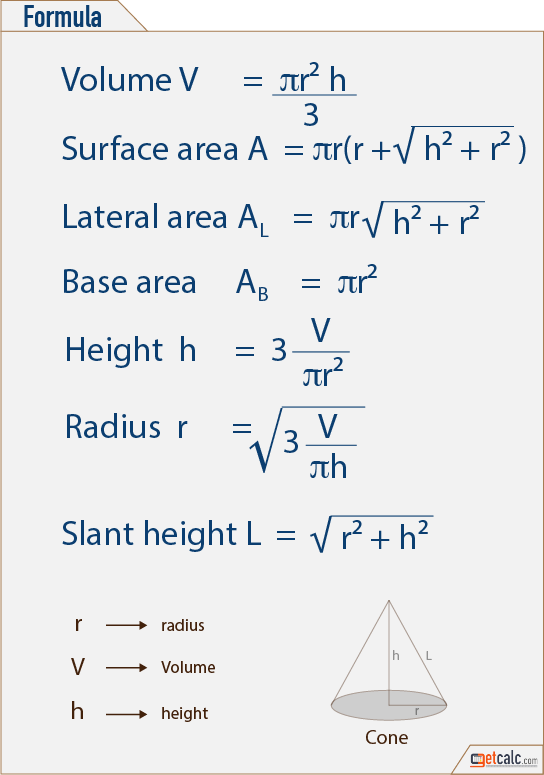Cone (Volume, Surface Area & Slanting Height) Calculator
getcalc.com's circular cone calculator is an online basic geometry tool to calculate volume, surface area, lateral surface & slant height of a cone shape, in both US customary & metric (SI) units.
Steps to Find Volume, Surface Area, Lateral Surface & Slant Height of a Cone
The step by step workout for how to find what is the volume, surface area, lateral surface and height of a cone. Students may use this cone calculator to generate work with steps for any other similar input values.workout :
step 1 Address the formula, input parmaeters & values
Radius = 5 in
Height = 10 in
step 2 Apply radius and height values in below volume formula
Volume V = πr²h/3
= π x (5)² x 10/3in³
= 3.1416 x (25) x 10/3in³
= 785.398/3in³
Volume V = 261.7994 in³
step 3 Apply radius and height in slant height formula
Slant height L = √(r² + h²) in²
= √(5² + 10²) in²
= √(25 + 100) in²
= √125 in
Slant height h = 11.1803 in
step 4 Find surface area using radius, height and slant height
Surface Area = πr(r + √r² + h²)
= πr(r + slant height)
= 3.1416 x 5 (5 + 11.1803) in²
= 3.1416 x 5 x 16.1803 in²
Surface Area = 254.1602 in²
step 5 Find lateral surface area using radius, height, ad slant height
Lateral Surafce Area = π r√r² + h²
= π x r x slant height
= 3.1416 x 5 x 11.1803 in²
Lateral Surafce Area = 175.6204 in²
Cone & Formulas
Cone is a three dimensional plane or geometric shape that generally tapers gradually from the base of circle to the top mid point called the apex. K-12 students may refer the below formulas of cone to know what are all the input parameters are being used to find the volume, surface area, lateral surface and slanting height of cone.

Problems on Volume, Surface Area & Slanting Height of Cone
- The radius & height of a cone measured as 15 inches and 20 inches respectively, find what is the volume, slanting height, lateral surface and the surface area of that cone?
- The radius of cone is 9 inches and the height is 6 inches, find what is the volume, slanting height, lateral surface and the surface area of that cone?

